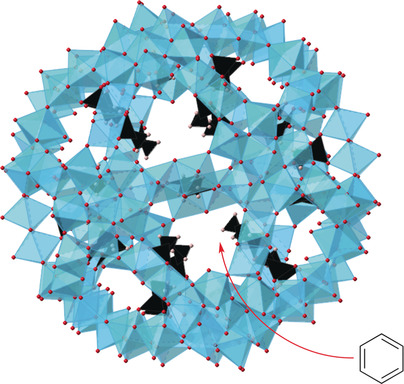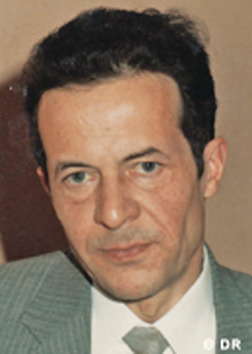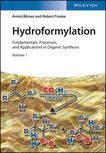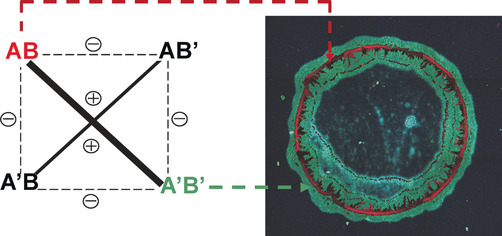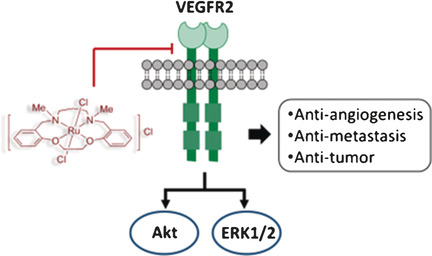Journal list menu
Export Citations
Download PDFs
Cover Pictures
Cover Picture: A Typical Metal-Ion-Responsive Color-Tunable Emitting Insulated π-Conjugated Polymer Film (Angew. Chem. Int. Ed. 43/2016)
- Page: 13351
- First Published: 06 September 2016
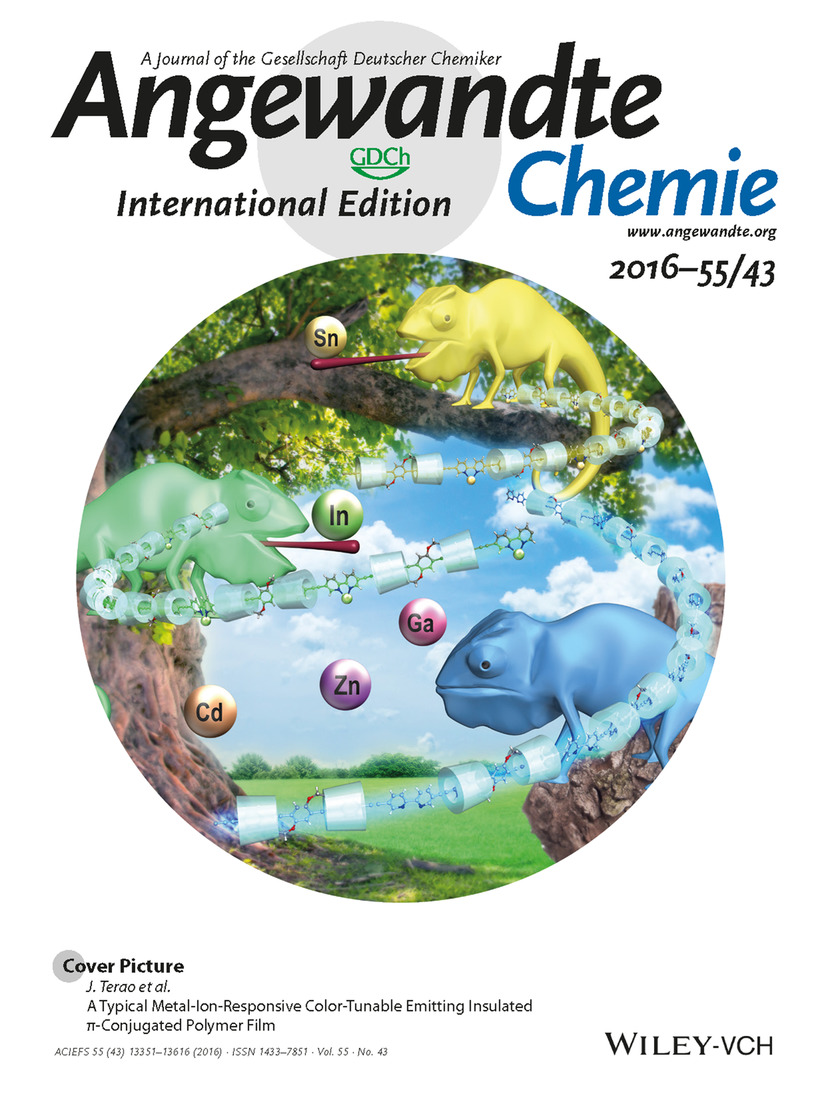
A chameleon polymer could be color-tuned easily, directly, and reversibly by metal coordination without changes to the main-chain skeleton. In their Communication on page 13427 ff., J. Terao et al. describe efficient emission from the metalated polymer even in the solid state, which is due to the permethylated α-cyclodextrin based insulation structure of the chameleon polymer. The synthesized polymer is expected to be suitable for application in recyclable luminescent sensors to distinguish different metal ions.
Inside Cover: Protein Patterns and Oscillations on Lipid Monolayers and in Microdroplets (Angew. Chem. Int. Ed. 43/2016)
- Page: 13352
- First Published: 13 September 2016
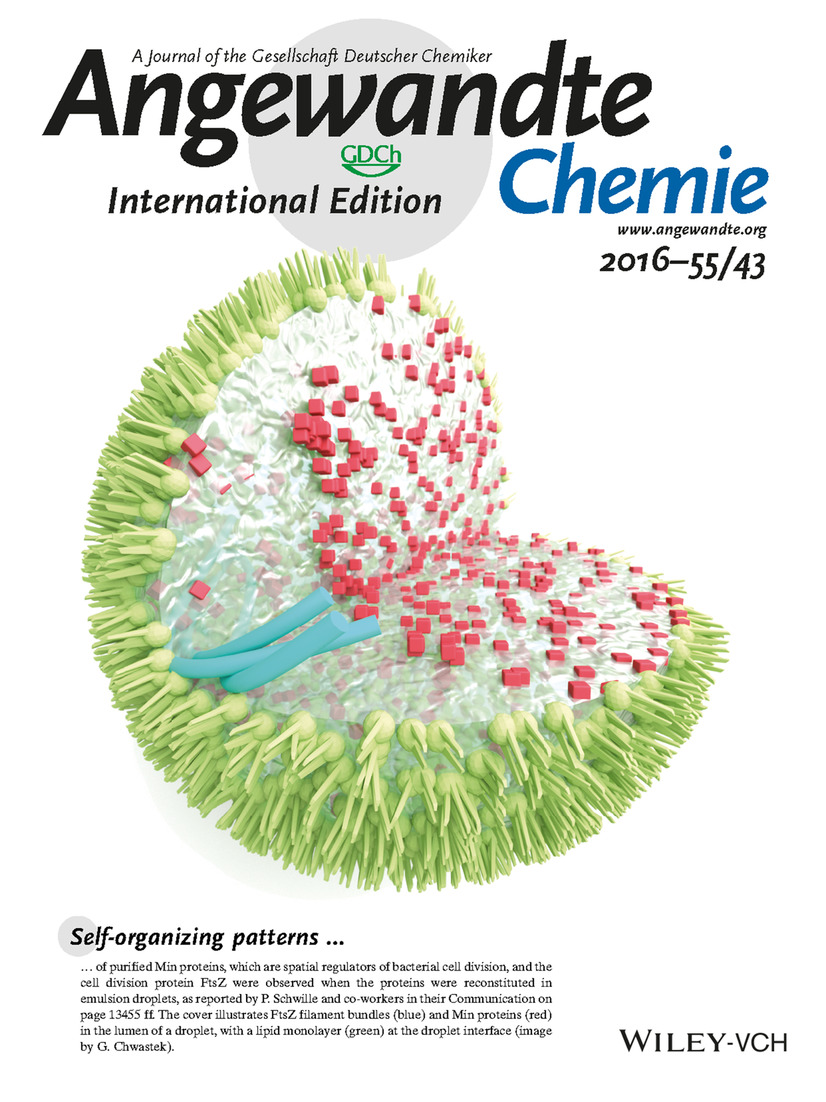
Self-organizing patterns of purified Min proteins, which are spatial regulators of bacterial cell division, and the cell division protein FtsZ were observed when the proteins were reconstituted in emulsion droplets, as reported by P. Schwille and co-workers in their Communication on page 13455 ff. The cover illustrates FtsZ filament bundles (blue) and Min proteins (red) in the lumen of a droplet, with a lipid monolayer (green) at the droplet interface (image by G. Chwastek).
Inside Back Cover: Vacancy-Induced Electronic Structure Variation of Acceptors and Correlation with Proton Conduction in Perovskite Oxides (Angew. Chem. Int. Ed. 43/2016)
- Page: 13615
- First Published: 28 September 2016
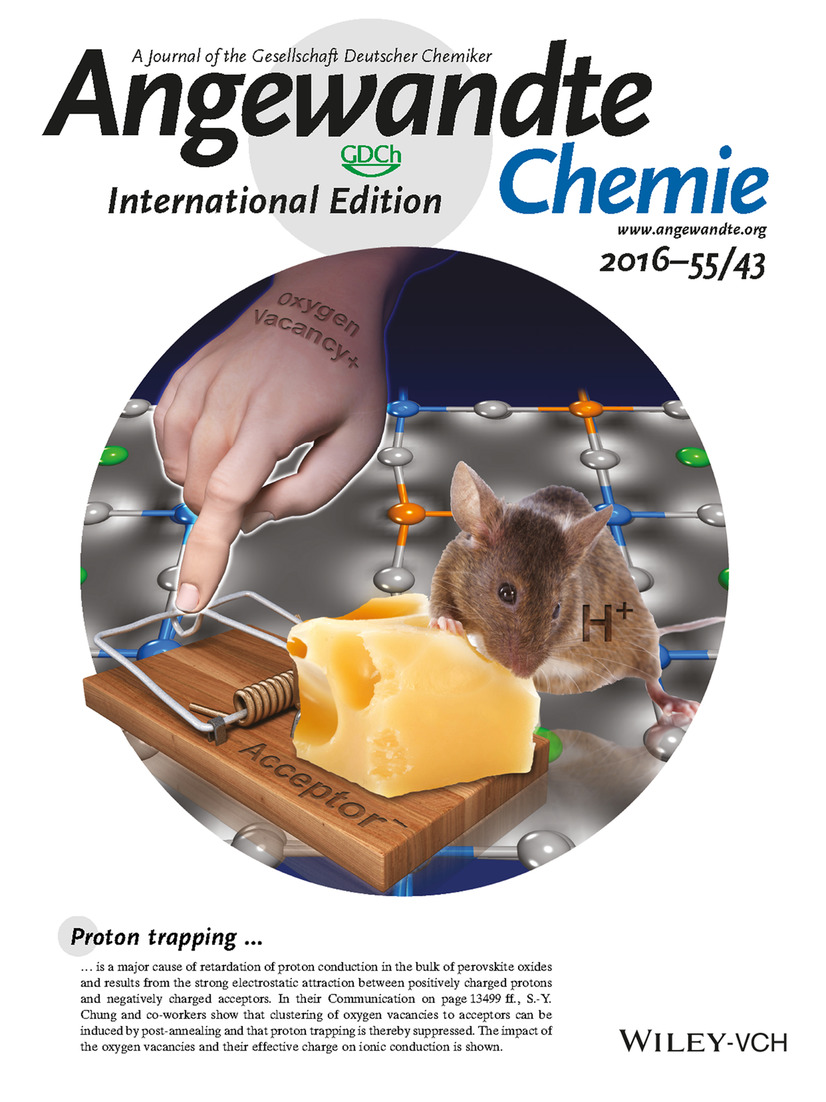
Proton trapping is a major cause of retardation of proton conduction in the bulk of perovskite oxides and results from the strong electrostatic attraction between positively charged protons and negatively charged acceptors. In their Communication on page 13499 ff., S.-Y. Chung and co-workers show that clustering of oxygen vacancies to acceptors can be induced by post-annealing and that proton trapping is thereby suppressed. The impact of the oxygen vacancies and their effective charge on ionic conduction is shown.
Back Cover: Multilayer Microcapsules for FRET Analysis and Two-Photon-Activated Photodynamic Therapy (Angew. Chem. Int. Ed. 43/2016)
- Page: 13616
- First Published: 19 August 2016
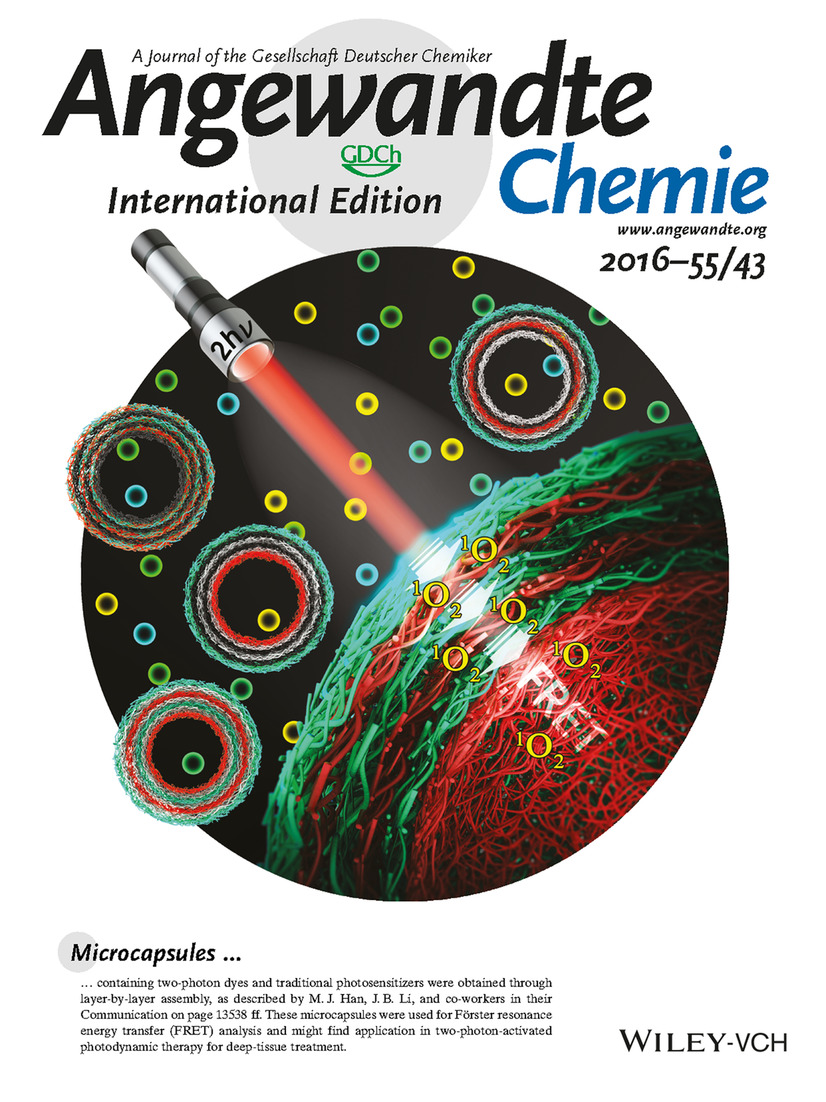
Microcapsules containing two-photon dyes and traditional photosensitizers were obtained through layer-by-layer assembly, as described by M. J. Han, J. B. Li, and co-workers in their Communication on page 13538 ff. These microcapsules were used for Förster resonance energy transfer (FRET) analysis and might find application in two-photon-activated photodynamic therapy for deep-tissue treatment.
Frontispiece
Frontispiece: Formation of CoS2 Nanobubble Hollow Prisms for Highly Reversible Lithium Storage
- First Published: 13 October 2016
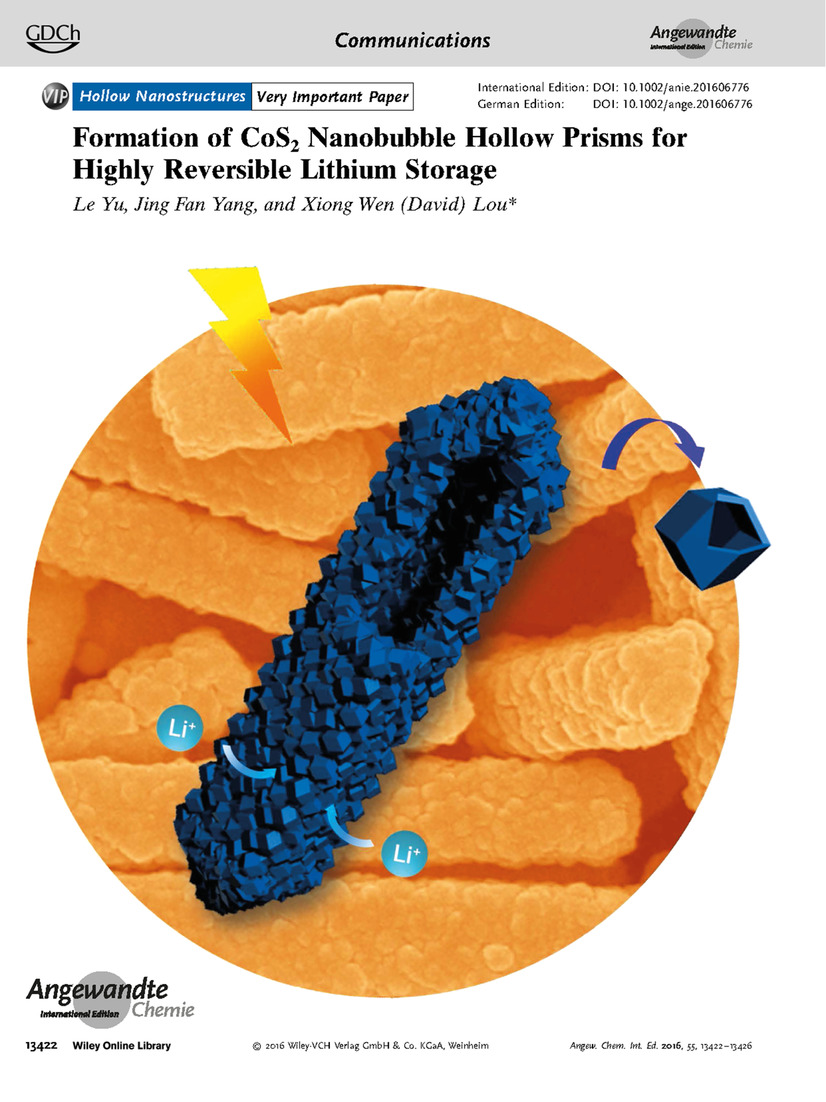
Lithium-Ion Batteries Hollow prisms formed from CoS2 nanobubbles are presented by X. W. Lou and co-workers in their Communication on page 13422 ff. The as-obtained hierarchical prisms are suitable anode materials for lithium-ion batteries.
Graphical Abstract
Graphical Abstract: Angew. Chem. Int. Ed. 43/2016
- Pages: 13355-13367
- First Published: 13 October 2016
News
Spotlights on our sister journals: Angew. Chem. Int. Ed. 43/2016
- Pages: 13370-13373
- First Published: 13 October 2016
Author Profiles
News
Obituaries
Book Reviews
Hydroformylation. Fundamentals, Processes, and Applications in Organic Synthesis. By Armin Börner and Robert Franke.
- Page: 13377
- First Published: 14 September 2016
Highlights
Beryllium Chemistry
New Avenues in s-Block Chemistry: Beryllium(0) Complexes
- Pages: 13380-13382
- First Published: 17 August 2016

A rarely used element: The chemistry of ligand-stabilized complexes in oxidation state zero was recently extended to the s block with the discovery of a Be1 complex stabilized by a cyclic (alkyl)(amino)carbene. Combined experimental and theoretical studies provided conclusive evidence that the complex contains beryllium(0).
Minireviews
Separation Membranes
Two-Dimensional-Material Membranes: A New Family of High-Performance Separation Membranes
- Pages: 13384-13397
- First Published: 01 July 2016
Janus Membranes
Janus Membranes: Exploring Duality for Advanced Separation
- Pages: 13398-13407
- First Published: 30 June 2016
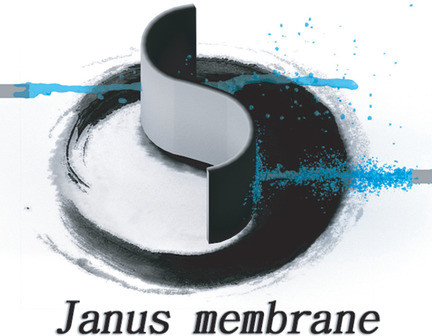
Crossing over: Janus membranes have received widespread interest over the past years. In this Minireview, a special definition of a Janus membrane is proposed and common fabrication methods of such membranes are outlined. Also summarized are the current and potential applications of Janus membranes in directional transport, switchable permeation, and performance optimization.
Reviews
Covalent Drugs
Targeted Covalent Inhibitors for Drug Design
- Pages: 13408-13421
- First Published: 19 August 2016
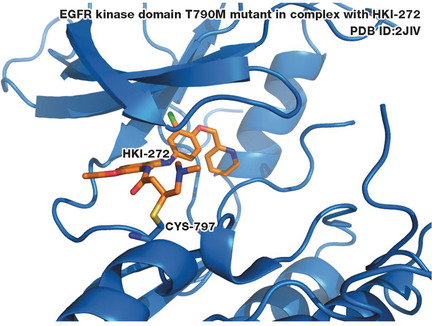
In a bind: Targeted covalent inhibitors (TCIs), such as HKI-272 (shown in the picture in complex with a protein), first form a reversible association and then a covalent bond between an electrophile on the ligand and a nucleophilic center in the protein. This can offer benefits such as high potency and extended duration of action, and new approaches can limit the risk of serious adverse reactions.
Communications
Hollow Nanostructures | Very Important Paper
Formation of CoS2 Nanobubble Hollow Prisms for Highly Reversible Lithium Storage
- Pages: 13422-13426
- First Published: 16 August 2016
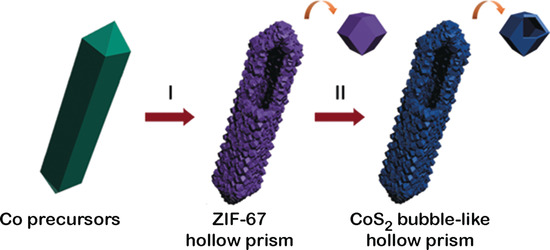
Bubble wrap: Novel hollow prisms formed from CoS2 nanobubbles have been synthesized via a facile two-step self-templating strategy. The diffusion-controlled processes are responsible for the formation of internal voids in the prism-like precursors and the ZIF-67 building blocks. The as-obtained hierarchical CoS2 hollow prisms show enhanced electrochemical properties when evaluated as an anode material for lithium-ion batteries.
Luminescent Polymer Materials | Very Important Paper
A Typical Metal-Ion-Responsive Color-Tunable Emitting Insulated π-Conjugated Polymer Film
- Pages: 13427-13431
- First Published: 07 July 2016
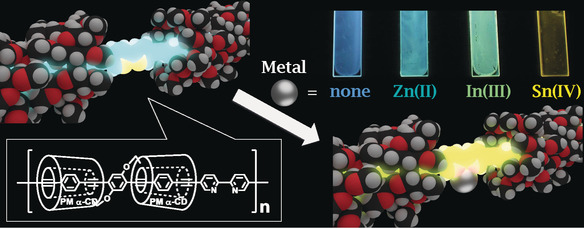
Metal-ion sensor: An insulated π-conjugated polymer containing metal-binding sites was synthesized. The coordination of metal ions to these sites alters the electronic properties of the polymer considerably. As a consequence the emission wavelength of the polymer varies and the polymer acts as a sensor for metal ions.
Atmospheric Chemistry
Heteroatom Tuning of Bimolecular Criegee Reactions and Its Implications
- Pages: 13432-13435
- First Published: 28 September 2016
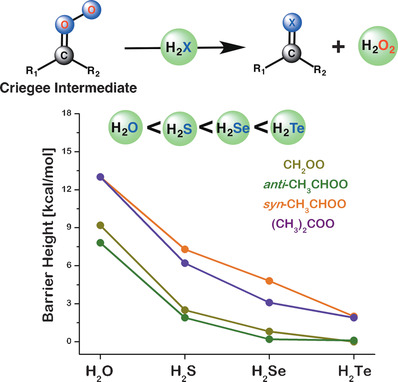
Gas-phase reactions: The calculated barriers for the bimolecular reactions of Criegee intermediates and H2X inversely correlate with the bond strength of the X−H bond of H2X or directly correlate with the first pKa value of H2X. Thus, it is not only the substitutions of Criegee intermediates but also the properties of the heteroatom in H2X that play a crucial role in determining the reactivity.
Alkaloid Synthesis
Expeditious and Divergent Total Syntheses of Aspidosperma Alkaloids Exploiting Iridium(I)-Catalyzed Generation of Reactive Enamine Intermediates
- Pages: 13436-13440
- First Published: 23 September 2016

Which way to go? A novel synthetic strategy for the divergent synthesis of different classes of aspidosperma alkaloids is described. Key step is the highly chemoselective iridium(I)-catalyzed reduction of cyclic lactams to enamine intermediates, followed by either a highly diastereoselective formal Diels–Alder reaction or a competitive Michael addition/reduction (see scheme; two examples shown).
Methane Oxidation
Low-Temperature Transformation of Methane to Methanol on Pd1O4 Single Sites Anchored on the Internal Surface of Microporous Silicate
- Pages: 13441-13445
- First Published: 26 September 2016
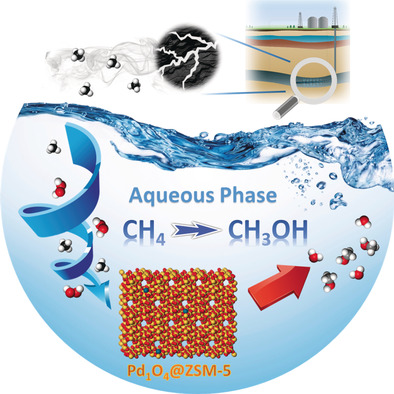
Single site Pd1O4 anchored in microspores of zeolite with 2.0 w % CuO is active for transforming of CH4 to CH3OH in aqueous solution in the temperature range of 50–95 °C. Selectivity for production of CH3OH in this temperature range was found to be 78 %-86 % at 50–95 °C, offering a clear improvement over harsh alternative conditions.
High-Pressure Synthesis
Discovery of a Superconducting Cu–Bi Intermetallic Compound by High-Pressure Synthesis
- Pages: 13446-13449
- First Published: 26 September 2016

Under pressure: A new superconducting intermetallic compound, Cu11Bi7, the first in the Cu−Bi binary system, was formed by high-pressure synthesis. The unique structure was determined from single-crystal X-ray diffraction, and the stabilization of the structure by pressure was confirmed by DFT calculations.
Adaptive Chemistry | Hot Paper
Adaptive Chemical Networks under Non-Equilibrium Conditions: The Evaporating Droplet
- Pages: 13450-13454
- First Published: 04 October 2016
Model Membranes
Protein Patterns and Oscillations on Lipid Monolayers and in Microdroplets
- Pages: 13455-13459
- First Published: 28 July 2016

Minimalistic approach: Min proteins (green or red), which are spatial regulator proteins of bacterial cell division, and the cell-division protein FtsZ (blue) were encapsulated in lipid monolayer microdroplets as a simple model of cellular compartments. Through interaction with a lipid membrane at the droplet boundary, the proteins self-organize into patterns that show distinct localization and oscillation modes.
Perovskite Solar Cells
Ion-Exchange-Induced 2D–3D Conversion of HMA1−xFAxPbI3Cl Perovskite into a High-Quality MA1−xFAxPbI3 Perovskite
- Pages: 13460-13464
- First Published: 26 September 2016
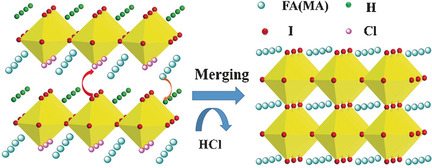
High-quality phase-pure MA1−xFAxPbI3 (x=0.1–0.9) perovskite planar films were deposited in a facile manner by a one-step method. 2D HMA1−xFAxPbI3Cl perovskite (left) was transformed into 3D MA1−xFAxPbI3 perovskite (right) by ion exchange. This 2D–3D perovskite conversion is a promising strategy for fabricating mixed-cation lead halide perovskites. MA=methylammonium, FA=formamidinium.
Carbene Analogues
Oligomerization of N-Heterocyclic Silylene into Zwitterionic Silenes
- Pages: 13465-13469
- First Published: 21 September 2016
Soft Matter
One-Step Microfluidic Fabrication of Polyelectrolyte Microcapsules in Aqueous Conditions for Protein Release
- Pages: 13470-13474
- First Published: 26 September 2016

Polyelectrolyte (PE) capsules: Using two immiscible aqueous solutions, dextran and PEG, transient double emulsions were created in a microfluidic system and used as templates to fabricate PE capsules. The capsule shell was formed by complexation of oppositely charged PEs, PE+ and PE−, at the interface of the two aqueous phases. This platform enables encapsulation and release of proteins without impairing their activity.
Encapsulation
Sequestration of Proteins by Fatty Acid Coacervates for Their Encapsulation within Vesicles
- Pages: 13475-13479
- First Published: 23 September 2016
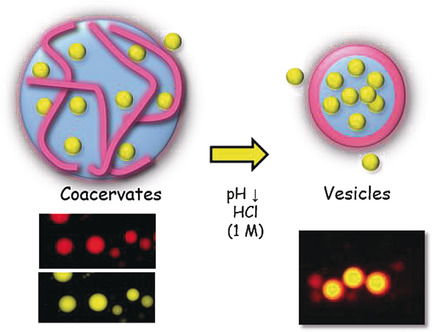
Vesicular microreactors: Fatty acid based, membrane-free coacervates spontaneously sequester proteins and can reversibly form membranous vesicles upon changing the pH value, which leads to protein encapsulation within the vesicles. These micrometric capsules also provide a suitable environment for enzymatic reactions.
Polyoxometalates
Closing Uranyl Polyoxometalate Capsules with Bismuth and Lead Polyoxocations
- Pages: 13480-13484
- First Published: 27 September 2016
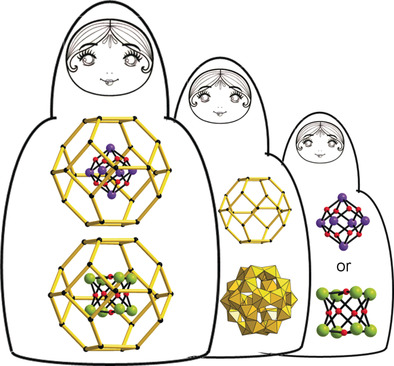
Heavy and heavier: Polyoxocations of the heavy metals bismuth and lead were nested inside uranyl polyoxoanion capsules, creating very distinctive X-ray scattering profiles. Matching symmetry and electrostatic attraction between the core and shell clusters enabled the formation of endohedral Pb@U24 and Bi@U24 in high yield and purity.
Inhibitors
Mirror-Image Packing Provides a Molecular Basis for the Nanomolar Equipotency of Enantiomers of an Experimental Herbicide
- Pages: 13485-13489
- First Published: 26 September 2016
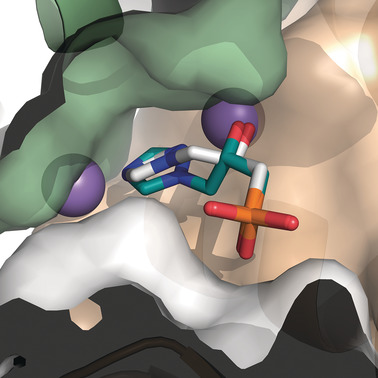
Chiral promiscuity: During a structure-led herbicide development program, both enantiomers of the lead compound were found to bind at the active site of the target with equal nanomolar potency. The main substituent groups lie in a plane, thus facilitating their equivalent interactions with the chiral surface of the enzyme by mirror-image packing, thus mimicking an achiral reaction intermediate.
Synthetic Methods
An Electrophilic Reagent for the Direct Introduction of the SCF2PO(OEt)2 Group to Molecules
- Pages: 13490-13494
- First Published: 26 September 2016
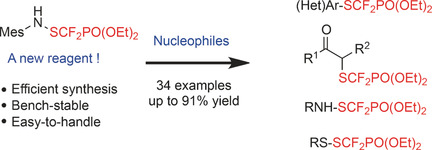
Tool up: A new electrophilic difluoromethylthiolating reagent (MesNHSCF2PO(OEt)2) was treated with various nucleophiles under mild and metal-free conditions, thus offering an efficient and operationally simple tool for the construction of C−SCF2PO(OR)2, N−SCF2PO(OR)2, and S−SCF2PO(OR)2 bonds. The versatility of this method was illustrated through the synthesis of the non-stereoidal anti-inflammatory compound diflumidone.
Asymmetric Catalysis
Catalytic Asymmetric C −H Functionalization under Photoredox Conditions by Radical Translocation and Stereocontrolled Alkene Addition
−H Functionalization under Photoredox Conditions by Radical Translocation and Stereocontrolled Alkene Addition
- Pages: 13495-13498
- First Published: 26 September 2016
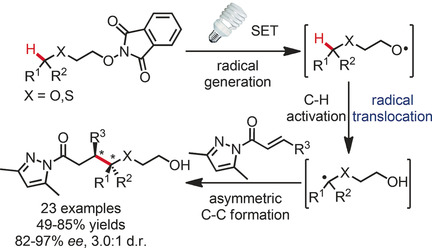
The light combo: Through radical translocation, a photoredox-mediated C(sp3)−H activation was combined with asymmetric catalysis. Upon irradiation with visible light, α,β-unsaturated N-acylpyrazoles react with N-alkoxyphthalimides in the presence of a rhodium-based chiral Lewis acid catalyst and the photosensitizer fac-[Ir(ppy)3] to provide a C−C bond-formation product with high enantioselectivity and, where applicable, with some diastereoselectivity.
Perovskite Phases
Vacancy-Induced Electronic Structure Variation of Acceptors and Correlation with Proton Conduction in Perovskite Oxides
- Pages: 13499-13503
- First Published: 16 August 2016
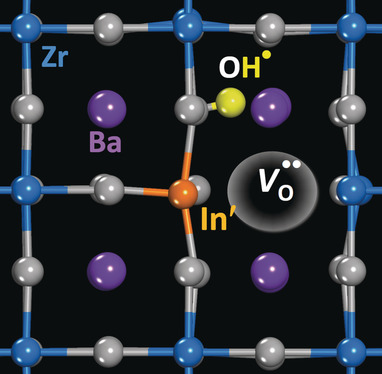
The value of nothing: The role of positively charged oxygen vacancies in proton conduction is demonstrated in acceptor-doped BaZrO3 and BaCeO3. A combination of density functional theory calculations, impedance spectroscopy, and atomic-column images shows that the control of acceptor-vacancy clustering is an efficient way of overcoming proton trapping toward acceptors.
Heterogeneous Structures
Fabrication of Hollow Materials by Fast Pyrolysis of Cellulose Composite Fibers with Heterogeneous Structures
- Pages: 13504-13508
- First Published: 27 September 2016
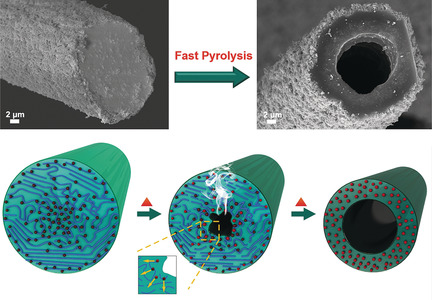
Hollow structural materials were fabricated from cuprammonium cellulose composite filaments by fast pyrolysis. The whole process could be completed within 100 s. The formation mechanism is related to the heterogeneous structure of the fibers and the gradient distribution of the metal oxides in the cellulose matrix.
Homogeneous Catalysis
Controlling Proton Delivery through Catalyst Structural Dynamics
- Pages: 13509-13513
- First Published: 27 September 2016
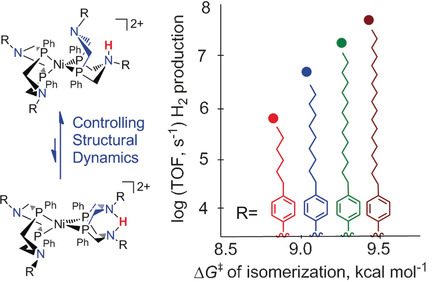
Slower dynamics, faster catalysis: Dynamic processes that are key to catalysis can be controlled through remote substituents in the outer coordination sphere, in a manner similar to the role of the protein architecture in enzymes. This approach was used to increase the H2 production rates of nickel catalysts by three orders of magnitude with a minimal increase in overpotential.
Azobenzenes | Hot Paper
Direct and Versatile Synthesis of Red-Shifted Azobenzenes
- Pages: 13514-13518
- First Published: 26 September 2016

Red-shifted tetra-ortho-substituted azobenzenes were synthesized in a rapid manner with high functional group tolerance (see picture). The privileged tetra-ortho-methoxy, -chloro, and -fluoro azobenzenes become readily accessible, which paves the way for future applications of red-shifted azobenzenes in material and biological sciences.
Helicenes
Electron Delocalization in Perylene Diimide Helicenes
- Pages: 13519-13523
- First Published: 26 September 2016
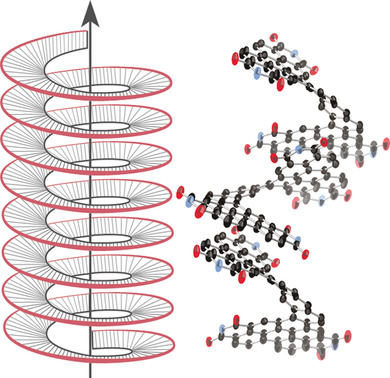
Two helicenes were synthesized by double fusion of an acene with two perylene diimide (PDI) subunits. These PDI-helicene homologs show different structural and electronic properties, despite differing by only a single ring in the link between the PDI units. The shorter link brings the two PDI subunits closer together, and this results in the collision of their respective π-electron clouds.
Anti-Cancer Complexes
A Macrocyclic Ruthenium(III) Complex Inhibits Angiogenesis with Down-Regulation of Vascular Endothelial Growth Factor Receptor-2 and Suppresses Tumor Growth In Vivo
- Pages: 13524-13528
- First Published: 26 September 2016
Total Synthesis
Enantioselective Pd-Catalyzed Allylic Alkylation Reactions of Dihydropyrido[1,2-a]indolone Substrates: Efficient Syntheses of (−)-Goniomitine, (+)-Aspidospermidine, and (−)-Quebrachamine
- Pages: 13529-13532
- First Published: 26 September 2016
![Enantioselective Pd-Catalyzed Allylic Alkylation Reactions of Dihydropyrido[1,2-a]indolone Substrates: Efficient Syntheses of (−)-Goniomitine, (+)-Aspidospermidine, and (−)-Quebrachamine](/cms/asset/e3aa18ba-c87a-4351-904f-be41922e402f/anie201608138-toc-0001-m.jpg)
Magnum (DH)PI: Application of dihydropyrido[1,2-a]indolone (DHPI) substrates in Pd-catalyzed asymmetric allylic alkylation chemistry enables rapid access to multiple alkaloid frameworks in an enantioselective fashion. The first catalytic enantioselective total synthesis of (−)-goniomitine, along with divergent formal syntheses of (+)-aspidospermidine and (−)-quebrachamine are reported.
Microemulsions for CO2 Reduction
Water-in-Supercritical CO2 Microemulsion Stabilized by a Metal Complex
- Pages: 13533-13537
- First Published: 27 September 2016
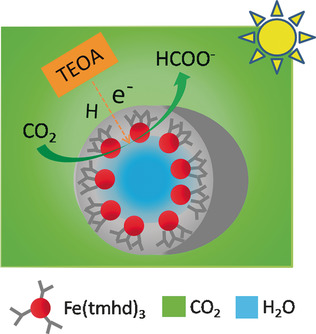
Second that emulsion: For the first time the utilization of a metal complex leads to the formation of water-in-scCO2 microemulsions. Such a microemulsion provides a promising route for in situ CO2 reduction to produce formic acid at the water/scCO2 interface, in a process that provides a high efficiency, adjustable activity, and easy product and catalyst separation.
Microcapsules
Multilayer Microcapsules for FRET Analysis and Two-Photon-Activated Photodynamic Therapy
- Pages: 13538-13543
- First Published: 16 August 2016

A layer-by-layer approach was adopted for the synthesis of microcapsules containing two-photon dyes (FITC) and traditional photosensitizers (RB) for two-photon-activated photodynamic therapy. The photosensitizers were indirectly activated by dyes in the same multilayer through one- or two-photon-induced Förster resonance energy transfer (FRET).
Carbonylation
Selective Palladium-Catalyzed Aminocarbonylation of Olefins to Branched Amides
- Pages: 13544-13548
- First Published: 26 September 2016

Branch out: A general protocol for iso-selective olefin aminocarbonylation has been developed. Key to success is the use of a specific 2-phosphino-substituted pyrrole ligand in the presence of PdX2. Bulk industrial and functionalized olefins react with various aliphatic amines, including amino acid derivatives, to give the corresponding branched amides in good yields and regioselectivities.
Click Chemistry
Harnessing the Dual Properties of Thiol-Grafted Cellulose Paper for Click Reactions: A Powerful Reducing Agent and Adsorbent for Cu
- Pages: 13549-13552
- First Published: 23 September 2016

Looks good on paper: An approach that exploits the dual properties of thiol-grafted cellulose paper for promoting copper-catalyzed [3+2]-cycloaddition of organic azides with alkynes and adsorbing residual copper species in solution was developed. Thiol-grafted cellulose paper effects the reduction of CuII to catalytically active CuI and acts as a powerful adsorbent for copper, thereby facilitating the work-up process.
RNA Modifications
Electrophilic RNA for Peptidyl-RNA Synthesis and Site-Specific Cross-Linking with tRNA-Binding Enzymes
- Pages: 13553-13557
- First Published: 26 September 2016
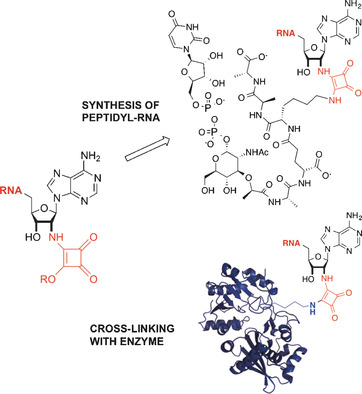
Electrophilic RNAs were synthesized to generate conjugates with native biomolecules. This strategy is based on diester-squarate-mediated coupling for post-functionalization of RNAs obtained by solid-phase synthesis. The unique reactivity of the squaramate RNAs provided specificity for cross-linking with defined amino groups in complex biomolecules.
Synthetic Methods
Copper-Catalyzed Vicinal Diphosphination of Styrenes: Access to 1,2-Bis(diphenylphosphino)ethane-Type Bidentate Ligands from Olefins
- Pages: 13558-13561
- First Published: 27 September 2016

Seeing double: A copper/N-heterocyclic carbene catalyzed oxidative vicinal diphosphination of styrenes with diphenyl(trimethylsilyl)phosphine proceeds to deliver the corresponding 1,2-bis(diphenylphosphino)ethanes in good yields. A pyridine N-oxide/MnO2 combined oxidant uniquely achieves the catalytic turnover of the copper.
Biocatalysis
Biocatalytic Synthesis of Allylic and Allenyl Sulfides through a Myoglobin-Catalyzed Doyle–Kirmse Reaction
- Pages: 13562-13566
- First Published: 20 September 2016

Biocatalytic Doyle-Kirmse reaction: Engineered variants of sperm whale myoglobin catalyze the tandem sulfur ylide formation/[2,3]-sigmatropic rearrangement of allylic and propargylic sulfides in the presence of α-diazo esters. This transformation can be applied to a variety of aryl, benzylic, and alkyl sulfide substrates, and gives high product conversion and enantioselectivity up to 71 % ee.
NMR Spectroscopy
Difference between Extra- and Intracellular T1 Values of Carboxylic Acids Affects the Quantitative Analysis of Cellular Kinetics by Hyperpolarized NMR
- Pages: 13567-13570
- First Published: 26 September 2016
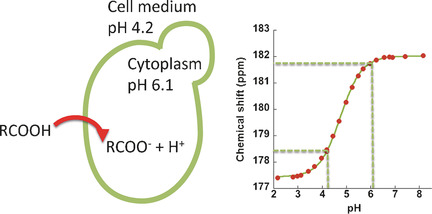
Time to relax: pH capture of small carboxylic acids inside cells allows measurement of their intracellular behavior with a unique pH-dependent chemical shift signature. The intracellular longitudinal relaxation constant (T1) of these acids is shown to be up to four-fold shorter than the corresponding extracellular T1. The result has a direct impact on the quantification of real-time cellular kinetics.
Cross-Coupling
Mixed Directing-Group Strategy: Oxidative C−H/C−H Bond Arylation of Unactivated Arenes by Cobalt Catalysis
- Pages: 13571-13575
- First Published: 21 September 2016

[Co(acac)3]-catalyzed oxidative C−H/C−H bond arylation of unactivated arenes enables the transformation of a wide range of benzamides and arylpyridines to afford bifunctionalized biaryls. A single-electron transfer (SET) and a concerted metalation–deprotonation (CMD) are involved. Moreover, the aryl radicals were trapped by 2,6-di-tert-butyl-4-methylphenol to form benzylated products.
Synthesis Design
Continuous Consecutive Reactions with Inter-Reaction Solvent Exchange by Membrane Separation
- Pages: 13576-13579
- First Published: 27 September 2016
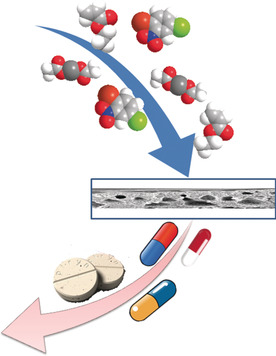
High to low: Two processes that complicate the transition from batch to continuous operations in multistep synthesis are solvent exchange (especially high-boiling- to low-boiling-point solvent) and catalyst separation. Described herein is membrane technology as an enabling platform for coupling these processes in a continuous operation.
Heterocycles
Generation of an 4-Isoxazolyl Anion Species: Facile Access to Multifunctionalized Isoxazoles
- Pages: 13580-13584
- First Published: 26 September 2016

Taking position: Preparation of a 4-isoxazolyl anion species from 4-iodoisoxazole using iPrMgCl⋅LiCl enabled introduction of a wide variety of functional groups into the 4-position of the isoxazole ring in good to excellent yields. This approach provides various isoxazolyl metal species which can be used for multifunctionalization of isoxazoles. The step-by-step synthesis of 3,4,5-trisubstituted isoxazoles was achieved by using the this 4-isoxazolyl anion method.
Lithium-Ion Mobility | Hot Paper
Supertetrahedral Networks and Lithium-Ion Mobility in Li2SiP2 and LiSi2P3
- Pages: 13585-13588
- First Published: 27 September 2016
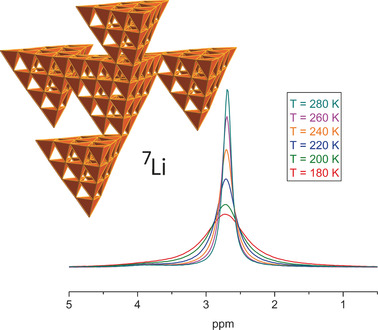
Mobile Li+ ions between supertetrahedra: The phosphidosilicates Li2SiP2 and LiSi2P3 form interpenetrating covalent networks of T2 or T4 and T5 supertetrahedra with diamond- or sphalerite-type topologies. 7Li solid-state MAS NMR analysis indicates the high mobility of the Li+ ions with small activation energies of 0.07–0.10 eV.
Biosynthesis
The Interplay between a Multifunctional Dehydratase Domain and a C-Methyltransferase Effects Olefin Shift in Ambruticin Biosynthesis
- Pages: 13589-13592
- First Published: 27 September 2016

Three in one: In vitro testing of the recombinant polyketide synthase domain AmbDH4 and the C-methyltransferase AmbM reveals their interplay during olefin shift in ambruticin biosynthesis. The AmbDH4 domain shows a triple activity as a dehydratase, epimerase, and enoyl isomerase. Subtle changes in the domain structure probably enable olefin shift via a similar mechanism to that reported for enoyl isomerases.
Terpene Biosynthesis
Lessons from 1,3-Hydride Shifts in Sesquiterpene Cyclizations
- Pages: 13593-13596
- First Published: 26 September 2016
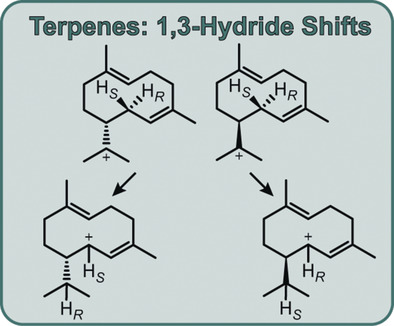
Jump ahead: Incubation experiments with (11-13C,1,1-2H2)FPP and stereospecifically labelled (1R)- and (1S)-(1-2H)FPP enabled assignment of the previously unknown absolute configurations of three bacterial sesquiterpenes from 1,3-hydride shifts, and provided first experimental evidence for a cyclization mechanism to amorphanes that was previously proposed on the basis of quantum chemical calculations.
Phosphorus Heterocycles
A Stable Crystalline Triarylphosphine Oxide Radical Anion
- Pages: 13597-13601
- First Published: 27 September 2016
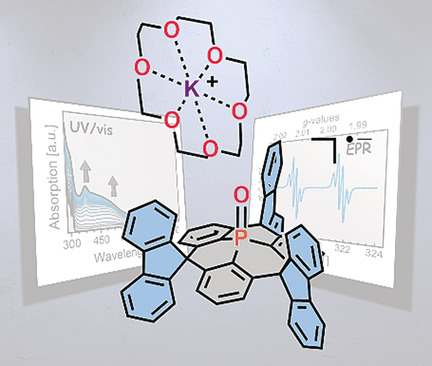
The spin within: A carefully designed triarylphosphine oxide scaffold with sterically demanding spirofluorenyl moieties undergoes chemical one-electron reduction at its phosphoryl moiety. The unique stability of the formed radical anion enables the isolation and X-ray crystallographic characterization of this hitherto elusive species.
Kinetic Resolution
Merging Iron Catalysis and Biocatalysis—Iron Carbonyl Complexes as Efficient Hydrogen Autotransfer Catalysts in Dynamic Kinetic Resolutions
- Pages: 13602-13605
- First Published: 29 September 2016
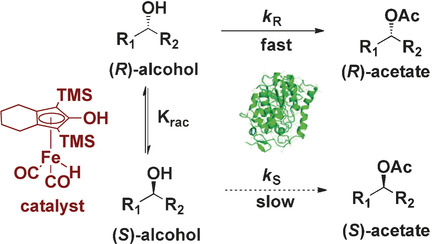
Iron can: Green and inexpensive iron carbonyl complexes are efficient catalysts for the racemization of chiral alcohols by mimicking the action of Fe-hydrogenases. The combination of the iron-based catalyst with lipase provides a platform for the enzymatic resolution of secondary alcohols. TMS=trimethylsilyl.
NMR Spectroscopy
1H-Detected Solid-State NMR Studies of Water-Inaccessible Proteins In Vitro and In Situ
- Pages: 13606-13610
- First Published: 27 September 2016
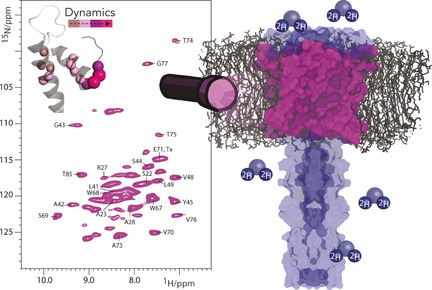
Within the membrane: An approach is presented that provides high-resolution 1H-detected solid-state NMR spectra of water-inaccessible proteins, even in complex environments, such as cellular surfaces. This method was used for studying the molecular motion of the transmembrane section of an ion channel in liposomes and directly in native cell membranes.
Biosynthesis
Discovery of a Mosaic-Like Biosynthetic Assembly Line with a Decarboxylative Off-Loading Mechanism through a Combination of Genome Mining and Imaging
- Pages: 13611-13614
- First Published: 26 September 2016
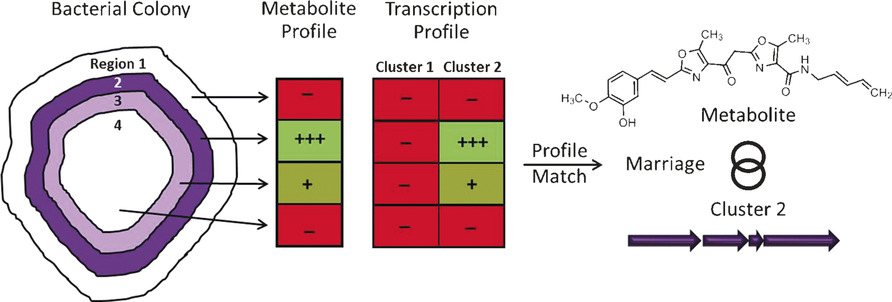
A mine of information: The biosynthetic gene cluster for the antiplasmodial natural product siphonazole from gliding bacteria of the genus Herpetosiphon was identified through a combination of genome mining, imaging, and expression studies. Product release proceeds through decarboxylation and dehydration.





